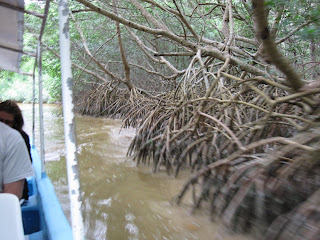This is the roof-top patio of our room at the Hotel Macanche in Izamal.
The B&B is a fairyland of gardens, peace and food!

Each room is an individual house, built
in the traditional Mayan style. The four of us shared one house, with one bathroom. It was very comfy and very pretty.
Stuart, enjoying an arrival beverage, in the open-air reception, dining room
and gathering area.


My dinner! Oh, what a great restaurant at the Macanche! We ordered our dinners early, and picked our serving time. The kitchen was smaller than the kitchen in my apartment in Merida, and the staff was one woman and her helper. So, guests at the Macanche are assigned meal times, to keep from overloading the cook. This evening, I had a fabulous sopa de poblano, and fish tacos (pictured here). It was the best meal of the trip!
There are only 7 rooms at the Macanche, all tucked into a beautifully planned garden.
Foliage and flowers, trees and a few veggies created a very quiet and private place to
wander or read. The pool was blasted, and the rocky bottom was so pretty, the owners
kept it natural. The water was cool, but it was refreshing.

The owners are yoga teachers, and the yoga palapa was beautiful! Emily was away while we were there, but we learned of future yoga retreats on the calender.
The reason to visit Izamal is to see the pretty village which is painted all the same golden color, and to visit one of the oldest pyramids in the Mayan Empire. The village is very small, and quiet. We walked the back streets, and found a some artists at work, carving wood or making papier mache butterflies. There are very few cars or trucks on the streets, everyone gets around either on a bicyle or horse and carriage, which makes the streets very quiet and pedestrian friendly.
We stayed at the lovely Macanche two nights. Salli and Doug headed back towards Cancun, where they are flying back to the States, and Stuart and I caught a bus back to Merida. The four of us had a VERY good time, and agreed that we travel well together!









